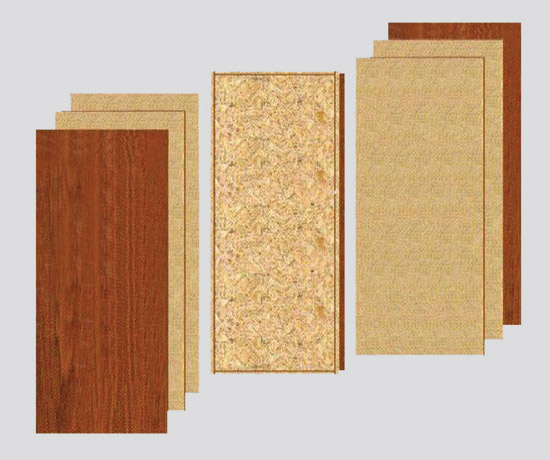What Architects Need to Know About Specifying Wood Doors
For architectural applications, such as hospitals, full-service hotels, and class A offices, five-ply wood door construction is the most commonly used method and is preferred by many architects because the crossbands provide increased stability, the face veneer is thicker than seven-ply, and the manufacturing technique provides a strong, durable bond between the ply. Seven-ply wood doors, which include a core, backer materials, crossbands, and thinner face materials, are commonly used for commercial applications. Nine- and 11-ply doors are generally residential doors.
Before delving further into door components, it is important to understand some fundamentals about performance standards. The Window and Door Manufacturers Association (WDMA, www.wdma.com) defines the standards of performance for windows, doors, and skylights in the residential and commercial building sectors and increases awareness of these standards among industry members by providing resources and educational professional programs.
WDMA standards for doors cover the aesthetics, performance (duty level, dimensional tolerance, flame spread), testing requirements, construction, and finishing expectations for a door for a particular opening. In 2011, the WDMA released two updated editions of its architectural wood flush door standards, the WDMA I.S. 1A-11, Industry Standard for Architectural Wood Flush Doors, and WDMA I.S. 6A-11, Industry Standard for Architectural Stile and Rail Doors. In addition, in 2011, WDMA established a new council, the WDMA National Architectural Door Council™ (NADC), to represent the interests of the leading manufacturers of architectural door manufacturers and their suppliers. In a three-fold mission, the council will not only develop and maintain industry standards for architectural wood doors, it will represent the industry before code and regulatory bodies, and the media, and promote WDMA architectural door standards to architects, specifiers, and contractors.
WDMA door descriptors are used to identify construction for architectural wood doors. Manufacturers use multiple naming systems or branding for their products and the WDMA descriptors standardize these offerings. They are critical for specification writers to identify doors without using proprietary names associated with a single door manufacturer, and they offer shorthand in specifying core, core assembly, and face material recognized by the door industry. For example, PC-5 describes a particleboard core door with veneer faces using five-ply construction with stiles and rails bonded to the core. PC-HPDL-5 is the same as above with high-pressure decorative laminate faces. An “F” is added to the descriptors to identify a non-bonded core assembly.
 |
Commonly used for commercial applications, seven-ply wood doors include a core, backer materials, crossbands, and thinner face materials. Image courtesy of VT Industries, Inc. |
WDMA also specifies performance duty levels for architectural wood doors. The Extra Heavy-Duty level typically involves doors where use is considered heavy and frequent, and requires the highest minimum performance standards. Applications include classrooms, patient rooms, public bathrooms, dormitory rooms, auditorium entry, detention and correctional facilities, gymnasiums, locker rooms, and surgical entry/trauma centers. The Heavy-Duty designation typically involves doors where usage is moderate, and requires intermediate minimum performance standards. Applications here include assisted living room entry, office-interior passage, stairwell, mechanical service, hallway, hotel/motel room entry, storage, apartment/condo entry, X-ray, acoustic, or medical examination rooms. Finally, the Standard Duty level typically involves doors where frequency of use is low, and requires the lowest minimum performance standards. Usages may include a closet, wardrobe, private bathroom, or low-usage office.









